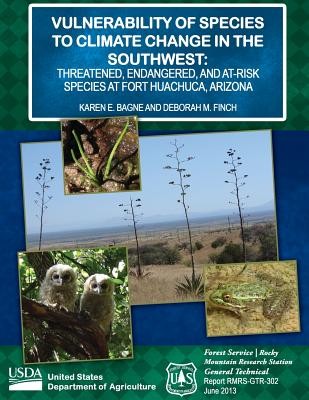
- We will send in 10–14 business days.
- Author: United States Department of Agriculture
- Publisher: CreateSpace Independent Publishing Platform
- Year: 2015
- Pages: 190
- ISBN-10: 1511632003
- ISBN-13: 9781511632003
- Format: 21.6 x 28 x 1 cm, softcover
- Language: English
- SAVE -10% with code: EXTRA
Vulnerability of Species to Climate Change in the Southwest (e-book) (used book) | bookbook.eu
Reviews
Description
Future climate change is anticipated to result in ecosystem changes, and consequently, many species are expected to become increasingly vulnerable to extinction. This scenario is of particular concern for threatened, endangered, and at-risk species (TER-S) or other rare species. The response of species to climate change is uncertain and will be the outcome of complex interactions and processes. Nevertheless, a simple flexible strategy is needed to help integrate climate change into management planning and actions. This assessment uses SAVS, a vulnerability scoring tool based on ecological principles, to rank individual species of interest within the Fort Huachuca region according to predicted climate change responses and associated population declines balanced with responses expected to incur resilience or population increases. Further, specific areas of vulnerability, research needs, and management implications are identified for each species. Based solely on predicted response to climate change, northern Mexican gartersnake and southwestern willow flycatcher are the most vulnerable to population declines. Results also suggest that climate change will make management of some TER-S more difficult. Several critical management areas are identified that can mitigate negative impacts to benefit multiple species, including fire and fuels, invasive species, natural and artificial waters, and landscape-scale planning. Management planning should be in place that will assist species impacted by extreme events such as prolonged drought, severe wildfires, and intense flooding. The assessment process was also used to identify areas where climate change may present opportunities, as opposed to challenges, for management of TER-S.
EXTRA 10 % discount with code: EXTRA
The promotion ends in 18d.23:19:22
The discount code is valid when purchasing from 10 €. Discounts do not stack.
- Author: United States Department of Agriculture
- Publisher: CreateSpace Independent Publishing Platform
- Year: 2015
- Pages: 190
- ISBN-10: 1511632003
- ISBN-13: 9781511632003
- Format: 21.6 x 28 x 1 cm, softcover
- Language: English English
Future climate change is anticipated to result in ecosystem changes, and consequently, many species are expected to become increasingly vulnerable to extinction. This scenario is of particular concern for threatened, endangered, and at-risk species (TER-S) or other rare species. The response of species to climate change is uncertain and will be the outcome of complex interactions and processes. Nevertheless, a simple flexible strategy is needed to help integrate climate change into management planning and actions. This assessment uses SAVS, a vulnerability scoring tool based on ecological principles, to rank individual species of interest within the Fort Huachuca region according to predicted climate change responses and associated population declines balanced with responses expected to incur resilience or population increases. Further, specific areas of vulnerability, research needs, and management implications are identified for each species. Based solely on predicted response to climate change, northern Mexican gartersnake and southwestern willow flycatcher are the most vulnerable to population declines. Results also suggest that climate change will make management of some TER-S more difficult. Several critical management areas are identified that can mitigate negative impacts to benefit multiple species, including fire and fuels, invasive species, natural and artificial waters, and landscape-scale planning. Management planning should be in place that will assist species impacted by extreme events such as prolonged drought, severe wildfires, and intense flooding. The assessment process was also used to identify areas where climate change may present opportunities, as opposed to challenges, for management of TER-S.


Reviews